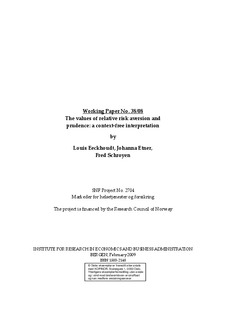| dc.contributor.author | Eeckhoudt, Louis | |
| dc.contributor.author | Etner, Johanna | |
| dc.contributor.author | Schroyen, Fred | |
| dc.date.accessioned | 2009-06-10T08:39:26Z | |
| dc.date.available | 2009-06-10T08:39:26Z | |
| dc.date.issued | 2009-02 | |
| dc.identifier.issn | 1503-2140 | |
| dc.identifier.uri | http://hdl.handle.net/11250/166638 | |
| dc.description.abstract | In this paper we apply to multiplicative lotteries the idea of preference for “harm disaggregation” that was used for additive lotteries in order to interpret the signs of successive derivatives of a utility function. In this way, we can explain in general terms why the values of the coefficients of relative risk aversion and relative prudence are usually compared respectively to 1 and 2. We also show how these values partition the sets of risk averse and/or prudent decision makers into two subgroups. | en |
| dc.language.iso | eng | en |
| dc.publisher | SNF | en |
| dc.relation.ispartofseries | Working paper | en |
| dc.relation.ispartofseries | 2008:38 | en |
| dc.subject | relative risk aversion | en |
| dc.subject | relative prudence | en |
| dc.title | The values of relative risk aversion and prudence : a context-free interpretation | en |
| dc.type | Working paper | en |
| dc.subject.nsi | VDP::Samfunnsvitenskap: 200::Økonomi: 210::Samfunnsøkonomi: 212 | en |
